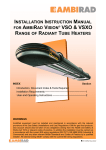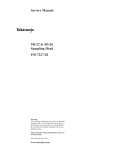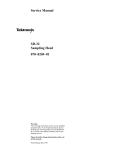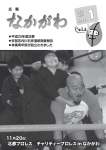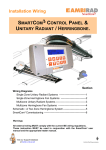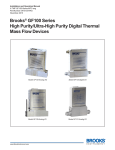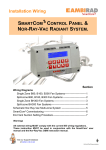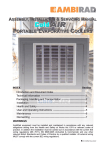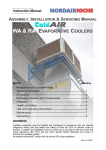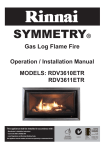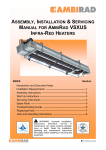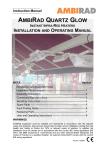Download AMBIRAD VISION SCHOOL HEATER KIT INSTALLATION MANUAL
Transcript
AMBIRAD ® VISION SCHOOL HEATER KIT INSTALLATION MANUAL REVISED 04/08/2011 AMBIRAD VISION® SCHOOL HEATER KIT INSTALLATION MANUAL INDEX Section ASSEMBLY, INSTALLATION & SERVICING MANUAL FOR AMBIRAD VISION® VS RANGE ---------------------------------------------------------------------- 1 VISION® HEATER BALL GUARD ASSEMBLY INSTRUCTION ---------------------------------------- APPENDIX 1 VS HEATER NOISE TROUBLESHOOTING GUIDE --------------------------------------------------- APPENDIX 2 ABEY GAS FLEX FLUE BROCHURE ---------------------------------------------------------------- APPENDIX 3 ABEY ROOFTITE INSTALLATION INSTRUCTIONS -------------------------------------------------- APPENDIX 4 AUSTRALIAN GAS ASSOCIATION APPROVAL FOR VISION® HEATERS ---------------------------- APPENDIX 5 VISION® COMMISSIONING CHECKLIST ----------------------------------------------------------- APPENDIX 6 OF RADIANT TUBE HEATERS ASSEMBLY, INSTALLATION & SERVICING MANUAL FOR AMBIRAD VISION® VS RANGE OF RADIANT TUBE HEATERS INDEX Section Introduction and Document Index Installation Requirements -------------------------------------------------1 Assembly Instructions------------------------------------------------------2 Commissioning Instructions ----------------------------------------------3 Servicing Instructions ------------------------------------------------------4 Spare Parts -------------------------------------------------------------------5 Fault Finding Guide --------------------------------------------------------6 Replacing Parts -------------------------------------------------------------7 User and Operating Instructions ----------------------------------------8 WARNINGS • • • • DO NOT PLACE ARTICLES ON OR AGAINST THIS APPLIANCE DO NOT USE OR STORE FLAMMABLE MATERIALS NEAR THIS APPLIANCE DO NOT SPRAY AEROSOLS IN THE VICINITY OF THIS APPLIANCE WHILE IT IS IN OPERATION CHECK WITH YOUR LOCAL SUPPLIER FOR DETAILS ABOUT SPECIFIC EQUIPMENT THAT HAS BEEN OMITTED OR MODIFIED Introduction. Welcome to the new range of high efficiency AmbiRad Vision radiant tube heaters. Local regulations may vary in the country of use and it is the installers responsibility to ensure that such regulations are satisfied All installation, assembly, commissioning and service procedures must be carried out by suitable qualified competent persons to the statutory regulations in the country of use. When assembling, installing, commissioning and servicing is undertaken on radiant tube heaters specified in these instructions, due care and attention is required to ensure that working at height regulations are adhered to at the mounting heights specified. PLEASE READ this document prior to installation to familiarise yourself with the components and tools you require at the various stages of assembly. All Dimensions shown are in mm unless otherwise stated. The manufacturer reserves the right to alter specifications without prior notice. Document Index. 2.2.9 Fan Assembly 2.2.10 DL Condensate Box Assembly 2.2.11 HB Damper Assembly 2.2.12 HB Manifold Assembly 2.2.13 Detailed Assembly Drawings 1 Installation Requirements 1.1 Health & Safety 1.2 Model Definitions 1.3 Heater Suspension 1.4 Wall Mounting 1.5 Herringbone Systems 1.6 Clearance to Combustibles 1.7 Gas Connection & Supply Details 1.8 Electrical Connections 1.9 Ventilation Requirements 1.9.1 Flued Radiant Heater Natural Ventilation Mechanical Ventilation 1.9.2 Unflued Radiant Heater Natural Ventilation Mechanical Ventilation 1.10 Flue & Combustion Air Inlet 1.10.1 Unitary Heaters 1.10.2 Herringbone systems 1.10.3 Ducted Air 1.11 Technical Details 2 Assembly Instructions 2.1 Tools Required 2.2 Assembly Notes 2.2.1 Tubes 2.2.2 Turbulators 2.2.3 Brackets 2.2.4 U Bends 2.2.5 Couplers 2.2.6 Reflectors 2.2.7 End Caps 2.2.8 Burner Assembly 3 Commissioning Instructions 3.1 Tools Required 3.2 Balancing the Herringbone System 3.3 Balancing a DL System 3.4 Commissioning Chart for VS Unitary Heaters 4 Servicing Instructions 4.1 Tools Required 4.2 Burner Description 4.3 Burner Removal 4.4 Burner Gas Injector Servicing 4.5 Burner Head and Electrode Servicing 4.6 Combustion Fan Assembly Induced Burner 4.7 Radiant Tube Servicing 4.8 Reflector Servicing 4.9 Inspection of Flue 4.10 Re-commissioning after Service 5 Spare Parts 6 Fault Finding Guide 7 Replacing Parts 7.1 Burner Controller Replacement 7.2 Air Pressure Switch Replacement 7.3 Gas Valve Replacement 8 User and Operating Instructions 8.1 To Start Heater 8.2 To Switch Off Heater 8.3 Routine Maintenance Between Service Intervals 8.4 Frequency of Servicing 1. Installation Requirements. and any other relevant statutory regulations, as well as the requirements of the local gas or electricity authority. Due account should also be taken of any obligations arising under the current Occupational Health and Safety Act and other relevant codes of practice. Isolate any electrical supply to the heater and controller before proceeding. 1.1 Health and Safety AmbiRad heaters must be installed in accordance with these instructions, local gas fitting regulations, municipal building codes, electrical wiring regulations, AS/NZS 5601.1, Isolate all electrical supplies to the heater & controller before proceeding. 2 For your own safety we recommend the use of safety boots and leather faced gloves when handling sharp or heavy items. The use of protective eye wear is also recommended. 1.2 These methods are illustrated in Figure 1.b. If there are any doubts as to the strength or suitability of roof steelwork to which heaters are to be suspended, please refer to a Consultant, Architect or owner of the building. The recommended mounting heights for AmbiRad heaters are given in the table above. Model Definitions VSUT = AmbiRad Vision U Tube heater with painted induced burner, stainless steel reflector & end caps. VSUH = AmbiRad Vision U Tube heater in Herringbone manifold configurations with painted induced burner, stainless steel reflector & end caps. VSLI = AmbiRad Vision Single Linear heater with painted induced burner, stainless steel reflector & end caps. VSLF = AmbiRad Vision Single Linear heater with painted Forced burner, stainless steel reflector & end caps. (Nat Gas ONLY) VSLH = AmbiRad Vision Linear heater in Herringbone manifold configurations with painted induced burner, stainless steel reflector & end caps. VSDL = AmbiRad Vision Double Linear heater with painted induced burner, stainless steel reflector & end caps. 1.4 These radiant tube heaters can be wall mounted using the appropriate bracket (AmbiRad part no WMB-13-22-38). When using the wall mounting brackets the heater must be inclined at an angle between 30° and 45°. Table 1 Angle Mounting U Tube Heater Required Size angle 15 - 25 35 VSAUT, VSAUH, VSALI, VSALF, VSALH & VSADL = As above except: aluminised reflector with no end caps. 1.3 Wall Mounting 10 links 13 links 12 links 16 links 1. See fig 1b. Attachment to the heater support lugs should be made by a ‘speed link’, D shackle or in the case of drop rods, a closed formed hook. The hanging attachments to overhead steelwork etc. must be purpose made to good sound engineering practice or of a proprietary type fixing. They must be adequately fixed and designed to carry the whole weight of the heater. In the event of suitable roof steelwork being unavailable, additional steelwork should be fitted to enable vertical hangers to be used for suspending the heaters. Recommended Mounting Height (m) Horizontal Inclined / wall mounted 15 4.0 - 5.0m 3.5 - 4.5m 25 5.0 - 8.0m 4.0 - 5.0m 35 6.0 - 10.0m 4.5 - 6.5m Eyebolt Chain position length 2 2 3 3 7 links 9 links 8 links 10 links Eyebolt position 1 1 1 1 Figure 1.a. Angle Mounting Using the Wall Mounting Bracket Heater Suspension Model 30-35° 45° 30-35° 45° Chain length Linear E 3 2. 3. On angle mounted UT installations the burner MUST be attached to the bottom tube. * * 4 ** Alternative suspension for Linear via single chain. SINGLE LINEAR SUSPENSION be equal and not more than 45°. * These angles to ** Vertical suspension chain ideal. Where supports are inclined, maximum recommended angle of inclination is 15°. * * Typical Speedlink attachment. Shackle method of attachment. Pin must be tightened by pliers. Drop rod with formed hook. note. hook or eyebolt must be closed tight. ON U TUBE VARIANTS THE HEATER SHOULD SLOPE DOWNWARDS TOWARDS THE RETURN BEND AND ON LINEAR VARIANTS SHOULD SLOPE DOWNWARDS TOWARDS BURNER BY APPROX. 10mm FOR BOTH HORIZONTAL AND WALL MOUNTED INSTALLATIONS. Vertical or inclined suspension on this plane is acceptable. U TUBE SUSPENSION Where chain supports have an angle of inclination greater than 15° an equal and opposite support is recommended. 15° max. Figure 1.b. Recommended Methods of Heater Suspension. 1.5 should be removed leaving the inside flush with the end cap. Herringbone systems (UH). The manifold system should be arranged to fall slightly in the direction of the vacuum fan. This ensures that any condensation formed in the manifold on cold start and cool down is not trapped or allowed to drain back into the heater unit. This allows condensate to flow towards the condensate trap located at the vacuum fan end of the manifold system. (See figure 2a below for condensate trap arrangement). The manifold should be supported by chain, stainless steel flexible wire, or other flexible means from the roof structure to allow movement caused by thermal expansion. For 100mm diameter manifold the maximum distance between supports is 2.4m and 3.0m for 150mm diameter. Figure 2b. Collecting Chamber Arrangement The end cap should be sealed with silicon jointing compound and pop riveted in position. All condensate drains from the flue collecting chamber to the disposal point shall be corrosion-resistant material of not less than 22mm internal diameter. Copper or copper based alloy shall not be used for condensation drains. Flexible couplers (supplied by Saacke) must be inserted within the manifold system to allow linear expansion to take place and prevent stress and strain on the system. The manifold must be supported either side of the flexible coupler. Condensate drain pipes must be protected against the effects of freezing. The exhaust flue should be adequately supported from the building structure and installed in accordance with AS/NZS 5601.1 to ensure ventilation requirements are satisfied. The Type ‘0’ and Type ‘2’ vacuum fans have bottom horizontal discharge with rectangular connections (flanged on the type 0) and must be mounted in that position by means of the fan support stool onto a suitable platform or brackets fixed to the building structure. A condensate trap assembly must be provided at the end of the manifold system before the hot gas vacuum fan. For details of the fan outlet fixing holes see below. The minimum depth of the condensate collecting chamber shall be 305mm and the minimum depth of the condensate drain pipe ‘U’ trap shall be 457mm deep. The end cap of the collecting chamber is to be fitted with a flush flanged tank connector. Any protrusion 5 213 190 457.0 Figure 2a. Condensate Trap Arrangement 305.0 Figure 2c. Type ‘O’ Fan Outlet Dimensions Figure 2d. Type 2 Fan Outlet Dimensions 305.0 For details of fan mounting bracket and fixing down holes see figure 3. Figure 2g. Stainless Steel Telescopic Through The Wall Arrangement (available for Type ‘O’ and Type ‘2’ fans) Where a conventional flue is to be installed, AmbiRad supply an aluminium transformation piece to which a 150mm (6ins) diameter flue must be attached. Figure 2e. Conventional Flue Arrangement Roof Exit. The length of flue which may be connected to the fan outlet must be adequately supported from the building structure. Figure 2f. Conventional Flue Arrangement Wall Exit. Figure 2h. Typical Low Fan Arrangement 6 Figure 3. Vacuum fan mounting details (Type ‘O’ fan illustrated) Hole Centres Fig 2c/d Hole Centres Fan Type O Type 2 A 124 80 B 38 35 C 175 174 D 7.1 7 E 209 125 F 153 100 G 42 25 H 239 120 J 340 210 K 332 205 L 363 215 Power (watts) 550 120 Running Current (amps) 2.6 0.8 Voltage 230V 1ph 230V 1ph 7 Figure 4. Typical Herringbone system Do’s and Don'ts of herringbone system Do’s Don’ts Check design pressure drop. Run drains in copper or mild steel pipework. Check for corrosive industrial process in Install system with extra 90° bends without asking proposed building - e.g. cleaning, electroplating, AmbiRad if the system will operate correctly. printers using sugar powder etc. Drain all flue ducts and seal all joints. Install flue with vertical rise without firstly fitting a drain point at it’s lowest level. Secure joints with pop rivets as well as sealing Fit fan with outlet vertical or with top horizontal compound (refer to assembly instructions). discharge. Fit drain traps before and after fans (see figs 2). Fit damper upside down or on it’s side. Fit expansion joints before fan and at Fit damper wrong way round. (see fig12 page 20.) intermediate points on the herringbone system. Run drains in galvanised steel or plastic pipes. Follow guide to combined flue heating system. 8 1.6 Clearance to Combustibles. The minimum clearances to combustible materials are given in the tables below. These minimum distances MUST be adhered to at all times. Figure 5. a Diagram illustrating the clearance to combustibles (U tube shown) B A/A1 F D E C VSUT / VSAUT 15 25 35 Above Reflector (VSUT NG ONLY) A 180 180 180 Above Reflector (VSAUT and ALL LPG ONLY) A1 280 280 280 Above Burner / Heater Outlet B 500 500 500 To the Sides C 900 1000 1100 Below Tubes D 1500 1700 2100 Horizontally from Heater Outlet (UNFLUED) E 1200 1200 1200 End Wall (VSUT ONLY) F 500 500 500 9 Figure 5.b Diagram illustrating the clearance to combustibles B A/A1 G/G1 F D C E C VS(A)LI; VS(A)LH; VS(A)DL 15 25 35 Above Reflector (VSLI/LH/DL NG ONLY) A 150 150 150 Above Reflector (VSALI/LH/DL NG and ALL LPG ONLY) A1 280 280 280 Above Burner B 500 500 500 To the Sides C 750 750 750 Below Tubes D 1500 1700 2100 Horizontally from Heater Outlet (UNFLUED) E 1200 1200 1200 End Wall F 500 500 500 Above Heater Outlet (FLUED) G 150 150 150 Above Heater Outlet (UNFLUED) G1 500 500 550 10 1.7 Take care when making a gas connection to the heater not to apply excessive turning force to the internal controls. Gas Connection and Supply Before installation, check that the local distribution conditions, nature of gas and pressure, and adjustment of the appliance are compatible. A final connection to the heater to allow safe linear expansion of the heater without creating undue stress on the gas supply pipe work must be used. It is therefore important that a tested and approved hose assembly to AS/NZS 1869 or a limited flexibility connector to AS 4361 is installed as per these instructions. A new gas meter (natural gas) or cylinder (propane) are to be connected to the service pipe by the Local Gas Authority or Licensed Plumber and Gas Fitter. An existing gas meter / cylinder should be checked, preferably by the Local Authority Supplier, to ensure that the meter is adequate for the rate of gas supply required. Installation pipes should be fitted in accordance with AS/NZS 5601.1, so that the supply pressure, as stated in Table 2 will be achieved. Ensure that expansion is taken up in the body of the hose and not on its attachment to the pipe work. The cone seat adapter supplied on one end of the flexible gas hose provides a `swivel` action, and must be fitted on the burner using a ½” BSP barrel nipple to provide ease of disconnection for future servicing. It is the responsibility of the competent engineer to ensure that other relevant Standards and Codes of Practice are complied with. Pipes of smaller size than the heater inlet gas connection must not be used. The minimum bore for flexible gas hose assembly is 19mm for the VS35 natural gas model. For all other models the minimum bore for the flexible gas hose assembly is 12mm. The complete installation must be tested for soundness as described in AS/NZS 5601.1. It is recommended that installation pipes be purged of any debris before being installed or after installation but before heaters are connected. The gas supply must not be in a position where it is subject to overheating. The installation layout described below is the only method recommended by AmbiRad and must only be carried out by a qualified / competent gas engineer. A gas union service cock MUST be fitted in the gas supply close to the heater, but not onto the burner itself. Figure 6. Correct Installation of Flexible Gas Connection x fig.b fig.a x fig.c 50 +/- 20mm 300 +/- 50mm Arrow denotes direction of expansion. Burner fig.d 11 fig.e Depending on the specific installation, the flexible gas hose may be routed to the gas cock at any of the following angles in relation to the burner: Vertical (fig.a) 45° angle (fig.b) 90° angle (fig.c) Any other position in between these angles is acceptable. Care must be taken to observe the minimum pipe bend diameter (minimum 250mm, maximum 350mm) & pipe expansion distance (minimum 30mm, maximum 70mm) as shown in fig.e. Maximum bend diameter for the 1000mm hose is 450mm. The correct installation as shown will allow for approx 100mm of movement due to expansion. A clearance distance ‘x’ of min 200mm must be observed to allow side door access . fig.f fig.g The methods shown in fig.f and fig.g are unacceptable, due to undue stress on the hose & fittings. Table 2 Gas Supply Pressures Natural Gas Propane Max Supply Pressure (kPa) 2.5 5.0 Min Supply Pressure (kPa) 1.0 2.5 Nominal Pressure (kPa) 1.13 2.75 Gas Type Gas Supply 1.8 Connection R½ ½in BSP Internal Thread Electrical Connections The flexible supply cables should be of 0.75mm² and comply with AS3000. The wires in the mains lead are coloured in accordance with the following code: Green & Yellow - Earth; Blue - Neutral; Brown - Live. This appliance must be earthed. Supply 240V 50Hz single phase. Standard heater 116W. Herringbone 16W. Current rating 0.55 amp max (inductive). Fuse: external 3 amp. All electrical work should be carried out to AS3000 standards by a competent electrician. The electrical connection to the heater is made by means of a three pin plug-in power connector. Live, neutral and earth connections should be made via a flexible supply cable to the power connector and routed clear of the heater or tubes. It is recommended the heater or group of heaters are controlled by thermostats, a time switch and if required manual control switches and a frost thermostat. We recommend use of AmbiRad approved controls. Please refer to control manual for siting and installation details. Where alternative manufactures controls are used, please refer to their instructions for their siting and installation details. 12 must facilitate complete isolation and should be made via a fused double pole isolator having contact separation of at least 3mm in all poles and supplying the appliance only. Alternatively, connection may be made via a fused three pin plug and unswitched shuttered socket, both complying with the requirements of AS3000. Ensure that a copy of the lighting instructions are affixed adjacent to the electricity supply IMPORTANT: All controls and switch gear must be rated to handle the total inductive load of the circuit they control. For inductive load per burner see 1.8 Electrical Connection, for herringbone fans see Figure 3. For large installations the use of relays or contactors should be considered. The method of connection to the electrical supply Figure 7.a Typical VSUT/VSAUT Wiring Connections Fused Spur Fan plugs into burner Figure 7.b Typical VSLI/VSALI Wiring Connections Fused Spur Fan plugs into burner via plug/socket supplied. Extension wiring by others Figure 7.c Typical VSDL Wiring Connections Fused Spur Fused Spur Fused Spur 13 Figure 8. Internal Burner Wiring Diagram. FAN IGNITOR GRN/YEL MAINS INPUT BURNER ON WHITE BLACK YELLOW GREY C. 14 12 3 7 11 2 10 1 9 BROWN LAMPS VALVE J.S.T. N.O. MAIN J.S.T. GREY BROWN MAINS ON 1 8 YELLOW 2 BLUE BLUE 3 BLUE 4 BLACK GREEN/YELLOW GREY SOLENOID VALVE N.C. BLACK L BLUE VACUUM SWITCH FLAME SENSOR WHITE N N PURPLE L GREEN/YELLOW EMC FILTER Figure 9. Typical Herringbone Wiring Connections Tail Pipe Burner 3 1 phase 230V Exhaust Fan Isolator Burner 2 1 phase Isolator Isolator Burner 1 0.75mm² Screened Cable Sensor Zone A Isolator Isolator 230V 50Hz 13A Mains Supply Controller opening must be located at or below the level of the heater. The upper opening must be located above the level of the draught diverter and positioned in relation to each other to provide a flow of air across the area. 1.9 Ventilation Requirements AmbiRad tube heaters can be operated as flued or unflued appliances providing the air supply and building ventilation requirements as stated in AS/NZS 5601.1 are complied with. A = F x T where: 1.9.1 Flued Radiant Heater Flued radiant heaters must incorporate a draught diverter (supplied as an optional extra by the manufacturer) which is fitted to the exit of the induced draught fan by means of the screws and clamp plates provided. The diverter is designed to accept a 125mm (5”) nominal bore proprietary twin wall metal flue pipe complying with AS/NZS 5601.1 The joint should be sealed with heat resistant caulking and faced off with fire cement. Alternatively, single wall metal flue pipe complying with AS/NZS 5601.1 may be used. A flue pipe should be adequately supported at regular intervals from the building structure and terminated externally with a certified flue cowl. The maximum flue length is 9.0m (30’) and the maximum number of bends is two. All connections in the flue pipe must be properly sealed. A = the minimum free ventilation area, in mm² F = the given factor shown below T = the total gas consumption of all heaters, in MJ/h Heaters in a room or enclosure vented directly to outside*; F = 300 Heaters in a room or enclosure vented via an adjacent room**; F = 600 Heaters in a plant room vented directly to outside*; F = 150 Heaters in a plant room vented via an adjacent room**; F = 300 * Outside means directly and without obstruction through an outside wall; though an outside wall but offset; into a cavity ventilated to outside; into an underfloor space ventilated to outside; into a roof space ventilated to outside. ** Openings based on this formula should apply to any subsequent rooms until ventilated to outside, or the total input of the heaters does not exceed 3MJ/h for each m³ of the total volume of the enclosure and rooms. Where the total input of the heaters exceed 3 MJ/h for each m³ (app. 800W/m³) of the room volume, the space must be ventilated by means of either natural or mechanical ventilation. Mechanical Ventilation. Air supply to the room may be drawn from outside by mechanical means in accordance with the requirements below. The lower opening must be located at or below the level of the heater. The upper opening must be located Natural Ventilation Two permanent openings must be provided each with a minimum free ventilation area calculated using the formula below. The lower 15 above the level of the draught diverter and positioned in relation to each other to provide a flow of air across the area. calculated using the formula below. The openings must be located so that the distance from the top of the upper opening to the ceiling and the distance from the bottom of the lower opening to the floor does not exceed 5% of the height of the room. The two openings may be combined if these distances exceed the 5%. Low level air supply. Minimum air flow required (L/s) = appliance input* in MJ/h x 0.3 A = F x T where: High level exhaust. Mechanical output (L/s) = between ¼ and ⅓ of the rate of inlet air required. A = the minimum free ventilation area, in mm² F = the given factor shown below T = the total gas consumption of all heaters, in MJ/h * Appliance input is to include the total input of all heaters in the area including those using other fuels. Interlock Where mechanical ventilation is used, an interlock must be provided to ensure the gas supply to the heaters is shut off in the event of a failure of the mechanical air supply system. The sensor used on this interlock must be one that will sense actual air movement and fail safe. Heaters in a room or enclosure vented directly to outside**; F = 300 Heaters in a room or enclosure vented via an adjacent room***; F = 600 Heaters in a plant room vented directly to outside**; F = 150 Heaters in a plant room vented via an adjacent room***; F = 300 The relevant authorities should be consulted as in some instances this flueing may not be required. ** Outside means directly and without obstruction through an outside wall; though an outside wall but offset; into a cavity ventilated to outside; into an underfloor space ventilated to outside; into a roof space ventilated to outside. *** openings based on this formula should apply to any subsequent rooms until ventilated to outside, or the total input of the heaters does not exceed 3MJ/h for each m³ of the total volume of the enclosure and rooms. Under no circumstances are heaters to be fitted to a power flue exhaust. Purpose designed Herringbone Systems are available upon request. Connection to a power flue exhaust will negate both Saacke / AmbiRad warranty and AGA approval certification. Mechanical Ventilation. Air supply to the room may be drawn from outside by mechanical means in accordance with the requirements below. The openings must be located so that the distance from the top of the upper opening to the ceiling and the distance from the bottom of the lower opening to the floor does not exceed 5% of the height of the room. The two openings may be combined if these distances exceed the 5%. 1.9.2 Unflued Radiant Heater Radiant tube heaters can be installed as unflued appliances when this is carried out in accordance with the current version of AS/NZS 5601.1 Gas Installation Code, Section ‘AIR SUPPLY TO APPLIANCES’. In addition to the ventilation requirements, consideration needs to be given to the possibility of condensation forming on cold surfaces. Low level air supply. Minimum air flow required (L/s) = appliance input* in MJ/h x 0.3 It should be noted that the clearance distance around the burner increases when the unit is operated unflued (see section 1.6). It should be ensured that the combustion gases do not impinge on any combustible materials. High level exhaust. Mechanical output (L/s) = between ¼ and ⅓ of the rate of inlet air required. Where the total input of the heaters exceed 3 MJ/h for each m³ (app. 800W/m³) of the room volume, the space must be ventilated by means of either natural or mechanical ventilation. Interlock Where mechanical ventilation is used, an interlock must be provided to ensure the gas supply to the heaters is shut off in the event of a failure of the mechanical air supply system. The sensor used on this interlock must be one that will sense actual air movement and fail safe. * Appliance input is to include the total input of all heaters in the area including those using other fuels. Natural Ventilation Two permanent openings must be provided each with a minimum free ventilation area 16 draught diverter on the outlet of the fan as supplied by Saacke as an optional extra. 1.10 Flue systems and Combustion Air Inlets 1.10.1 Unitary Heaters 1.10.3 Ducted Air option Flued heaters must be run in either Ø125mm single skin or twin wall flue system (see fig.10) All flues must terminate vertically. Maximum flue length = 9.0m @ Ø125mm Maximum no of bends = 2 For further information on flue runs, please refer to AS/NZS 5601.1 Ducted air must be used in locations where there is airborne dust or where there is a polluted atmosphere e.g. Chlorinated Vapours. A ducted air intake adapter plate is optional (see fig.10) Maximum length = 9.0m Minimum diameter = 100mm Maximum no of bends = 2 1.10.2 Herringbone systems A weather proof cowl must be fitted to the air duct inlet terminal. Note: Air for combustion must not be impeded by a restrictive cowl. If the duct inlet is located on a roof the underside of the inlet cowl must be at least 500mm above roof level and at least 2500mm higher than any projection on the roof within a 2m radius of the cowl. All Herringbone flue systems must be run in minimum Ø100mm. Maximum flue length = 11.0m Maximum no of 90° bends = 4 For further information on flue runs, please refer to AS/NZS 5601.1 All Herringbone systems must be fitted with a Figure 10. Unitary Flue Attachment Induced Burners (VSUT or VSAUT) For non-flued installations, delete items A and B and rotate fan outlet to the HORIZONTAL position away from the burner. Ducted Air Intake Products of Combustion A 127mm (5”) Twin Wall Flue System D B Draught Diverter 202301 / 20XXXX A C Fan 2501 / 2507 / 2560 D Optional Ducted Air Intake. VSI-DA E B E Standard Air Intake (supplied as standard) Firing tube C Products of combustion 17 1.11 Technical Details. Table 3 - Natural Gas 1 No of Injectors ½ in BSP Internal thread Gas Connection Flue Nominal Bore mm (in) 125 (5) Unitary Fan Motor Details 240 volt 1 phase 50Hz Heater Model Gross Heat Input kW Gas Injector Injector Flowrate Pressure Size (m³/hr) (kPa) (mm) MJ/h Size (h x l x w) Fan Weight Rating (Kg) (A) Fan Type VS(A)15UT 15.2 54.7 1.4 0.74 7 x 1.4 240x3417x500 43 0.5 2501 VS(A)15UH 15.2 54.7 1.4 0.74 7 x 1.4 240x3417x500 42 N/A N/A VS(A)25UT 23.5 84.6 2.3 0.80 7 x 1.8 240x5066x500 60 1.0 2507 VS(A)25UH 23.5 84.6 2.3 0.80 7 x 1.8 240x5066x500 59 N/A N/A VS(A)35UT 36.0 129.6 3.4 0.80 7 x 2.4 260x5709x670 92 0.5 2560 VS(A)35UH 36.0 129.6 3.4 0.80 7 x 2.4 260x5709x670 91 N/A N/A Gas Injector Injector Size Flowrate Pressure (m³/hr) (kPa) (mm) MJ/h Size (h x l x w) Fan Weight Rating (Kg) (A) Fan Type Heater Model Gross Heat Input kW VS(A)15LI6 15.2 54.7 1.4 0.74 7 x 1.4 390x5725x315 43 0.5 2501 VS(A)15LH6 15.2 54.7 1.4 0.74 7 x 1.4 390x5725x315 42 N/A N/A VS(A)35LI10-5 36.0 129.6 3.4 0.80 7 x 2.4 390x10787x470 103 0.5 2560 VS(A)35LH10-5 36.0 129.6 3.4 0.80 7 x 2.4 390x10787x470 101 N/A N/A Fan Weight Rating (Kg) (A) Fan Type Table 4 Technical Details - Propane Gas Heater Model Gross Heat Input Gross Injector Injector Flowrate Pressure Size (l/hr) (kPa) (mm) MJ/h Size (h x l x w) VS(A)15UT 15.2 54.7 2.16 2.00 4 x 1.2 240x3417x500 43 0.5 2501 VS(A)15UH 15.2 54.7 2.16 2.00 4 x 1.2 240x3417x500 42 N/A N/A VS(A)25UT 23.5 84.6 3.34 1.08 7 x 1.3 240x5066x500 60 1.0 2507 VS(A)25UH 23.5 84.6 3.34 1.08 7 x 1.3 240x5066x500 59 N/A N/A VS(A)35UT 37.0 133.2 5.26 2.24 7 x 1.4 260x5709x670 92 0.5 2560 VS(A)35UH 37.0 133.2 5.26 2.24 7 x 1.4 260x5709x670 91 N/A N/A 18 Heater Model Gross Heat Input Gross Injector Injector Flowrate Pressure Size (l/hr) (kPa) (mm) MJ/h Size (h x l x w) Fan Weight Rating (Kg) (A) Fan Type VS(A)15LI6 15.2 54.7 2.16 2.00 4 x 1.2 390x5725x315 43 0.5 2501 VS(A)15LH6 15.2 54.7 2.16 2.00 4 x 1.2 390x5725x315 42 N/A N/A VS(A)35LI10-5 37.0 133.2 5.26 2.24 7 x 1.4 390x10787x470 103 0.5 2560 VS(A)35LH10-5 37.0 133.2 5.26 2.24 7 x 1.4 390x10787x470 101 N/A N/A Table 5. Herringbone Vacuum Fan characteristics Fan type Type ‘O’ Type ‘2’ Power (W) 550 120 2.6 0.8 Single Single 230 230 Running current (overload setting) (A) Phase Voltage (V) Table 6. Herringbone & DL Settings- Natural Gas Model Cold HB Pressure Hot HB Pressure kPa mbar kPa mbar VS(A)15UH 0.25 2.5 0.14 1.4 VS(A)25UH 0.24 2.4 0.20 2.0 VS(A)35UH 0.30 3.0 0.20 2.0 VS(A)15LH6/DL12 0.27 2.7 0.14 1.4 VS(A)35LH10-5/DL21 0.33 3.3 0.18 1.8 Table 7. Herringbone & DL Settings- Propane Gas Model Cold HB Pressure Hot HB Pressure kPa mbar kPa mbar VS(A)15UH 0.25 2.5 0.15 1.5 VS(A)25UH 0.24 2.4 0.21 2.1 VS(A)35UH 0.37 3.7 0.23 2.3 VS(A)15LH6/DL12 0.27 2.7 0.14 1.4 VS(A)35LH10-5/DL21 0.37 3.7 0.23 2.3 19 2. Assembly Instructions. PLEASE READ this section prior assembly to familiarise yourself with components and tools you require at various stages of assembly. Carefully open packaging and check the contents against parts and check list. to the the the the Please ensure that all packaging is disposed of in a safe and environmentally friendly way. For your own safety we recommend the use of safety boots and leather faced gloves when handling sharp or heavy items. The use of protective eye wear is also recommended. The manufacturer reserves the right to alter specifications without prior notice. 2.1 Tools Required. The following tools and equipment are advisable to complete the tasks laid out in this manual. Suitable alternative tools may be used. Trestles Leather Faced Gloves Pozidrive Screwdriver Wrench With Extension 13mm Socket Tape Measure Saw 2.2 Pop Riveter & 3/16” Rivets Silicone Sealant & Gun 10mm, 12mm & 13mm Spanners 4 & 5mm Allen Keys Herringbone Systems Only Assembly Notes. 2.2.2 Turbulators Please read these assembly notes in conjunction with the correct assembly drawings (figs 11 to 15). Insert turbulator(s) into tube(s) ensuring the correct length and quantity are inserted into their respective correctly identified tube(s) as detailed in the assembly drawings. 2.2.3 Brackets 2.2.1 Tubes There can be three types of brackets supplied with these heaters: Identify and position tubes on trestles. For aesthetics it is advisable to position the tube seam so that these cannot be seen from beneath the heater. Mark out the position of the bracket centres from the dimensions shown on the assembly drawings. • • • Type ‘A’ are suspending brackets with reflector fixing points. Type ‘B’ are suspending brackets with no fixing points. Type ‘C’ is a centre bracket to retain the reflector (certain models only). Slide the bracket assemblies along the tubes to the marked positions in their correct order as detailed in the assembly drawing. Tighten clamping ‘U’ bolt arrangement to tubes ONLY WHERE STATED on the assembly drawings. 20 fixing points. Secure overlapped reflectors to bracket using M6 nuts, bolts and flat mud washers. All reflectors must be positioned/ attached to the brackets exactly as detailed in the assembly drawings. 2.2.4 U Bend. For VS(A) ‘U’ tube heaters only. Slide the ‘U’ bend onto the tube ends with the clamping bolts facing upwards until the predefined stop position. Tighten clamping bolt arrangement using 13mm socket and wrench. Remove the protective plastic coating. 2.2.7 End Caps. On VSUT models only, position the end cap with no tube holes beneath the reflector profile at the U bend end with the end cap flanges facing inwards. Fasten to reflector using M5 pozi set pin and ‘Z’ clips. Position the end cap with tube holes beneath the reflector profile at the burner end with the end cap flanges facing inwards. Fasten to reflector using M5 pozi set pin and ‘Z’ clips. 2.2.5 Couplers For VS(A)LI, LH and DL heaters only. For joining radiant tubes, locate and position tube couplers at the end of the tubes so that the socket heads are facing outwards. Tighten clamping bolt arrangement to secure ensuring the bolts are not over tightened. On VS(A)LI, LH and DL models only, position ONE end cap beneath the reflector profile at the fan/damper end with the end cap flanges facing inwards. Fasten to reflector using ‘Z’ clips. Position the other end cap beneath the reflector profile at the burner end with the end cap flanges facing inwards. Fasten to reflector using ‘Z’ clips. To avoid damaging the heater whilst installing we recommend the heater chassis be suspended prior to fitting reflectors. M5 set pin End Cap 2.2.6 Reflectors. 2 x ‘Z’ clips After removing the protective plastic coating, slip the reflector through the brackets until the locating slots are aligned with the type A or C bracket fixing points. These holes Burner end only 2.2.8 Burner Assembly. Slide the next reflector through the brackets and overlap the existing reflector until the locating slots line up with the same bracket On VS(A)UT only, slide the burner assembly onto the RIGHT HAND TUBE when viewed 21 from above, ensuring it is fully engaged. Secure with grub screws. Manifold Tube Damper Blade Vacuum Test Point FLOW On VS(A)LI, LH and DL models only, slide the burner assembly onto the inlet end of the tube ensuring it is fully engaged. Secure with grub screws. Emitter Tube FLOW 2.2.9 Fan Assembly. On U Tube heaters only, slide fan onto the left hand tube ensuring it is fully engaged. The fan discharge should face vertically for individually flued or horizontally away from the burner if unflued. Method of jointing aluminium tube Using the applicator gun exude 4mm diameter bead of high temperature silicon jointing compound externally round the end of the fitting and internally round the end of the tube. 2.2.10 Condensate Box Assembly. On VS(A)DL models only, slide the condensate box flange onto the outlet end of the tube ensuring it is fully engaged. Secure with grub screws. Fitting External bead of jointing compound Internal bead of jointing compound Manifold 2.2.11 Herringbone Damper Assembly. Enter the fitting into the tube using a slight rotating movement to spread the jointing compound uniformly until a penetration of 75mm (3in) is achieved. On VS(A)UH and VS(A)LH models only, slide the damper assembly flange onto the outlet end of the tube ensuring it is fully engaged. Secure with grub screws. Note: The damper assembly must be located with its damper blade vertical and left in the closed position. The manifold tube is to be sealed and secured (as described below) to the damper assembly. Note The silicon jointing compound remains workable after application for only 5 minutes. 2.2.12 Herringbone Manifold Assembly. VS(A)UH and VS(A)LH models only. After fixing the heaters in the desired position, the manifold system requires fitting. After allowing for a minimum of 75mm (3in) of penetration of the fitting into the tube, cut the tubes to the lengths required and remove all burrs and wipe off any grease or oil with a clean rag. 22 Secure the joint by drilling through the tube and fitting and fix with three pop rivets at 12 o’clock, 4 o’clock and 8 o’clock positions. 4.8mm (3/16in) diameter pop rivets are recommended. 2.2.13 Detailed Assembly Drawings The following page shows the technical dimensional details for the VSUT / VSAUT, VSUH / VSAUH, and VSLI / VSALI, VSLH / VSALH, VSDL / VSADL range of heaters. Please note the heater type and reference number from the delivery/advice note before identifying the correct model drawing. 23 FIGURE 2 FIGURE 3 M6 FIGURE 1 FIGURE 1 SEE FIGURE 1 Figure 11. Vision Heater Assembly: Models VS/VSA U tube 15kW - 75mm (3ins) Nom Dia. 24 FIGURE 2 FIGURE 3 M6 FIGURE 1 FIGURE 1 SEE FIGURE 2 SEE FIGURE 1 Figure 12. Vision Heater Assembly: Models VS/VSA U tube 25kW - 75mm (3ins) Nom Dia. 25 FIGURE 2 FIGURE 3 SEE FIGURE 1 FIGURE 1 SEE FIGURE 1 Figure 13. Vision Heater Assembly: Models VS/VSA U tube 35kW - 100mm (4ins) Nom Dia. 26 FIGURE 2 FIGURE 1 IMPORTANT: ENSURE FIRST REFLECTOR OVERLAPS SECOND REFLECTOR. 27 VS15DL 12 VS15LH 6 VS15LI 6 Figure 14. Vision Heater Assembly: Models VSLI/VSLH/VSDL 15kW 6m - 75mm (3ins) Nom Dia. FIG. 2 FIGURE 1 VSLI - 10787 28 VS35DL 21 VS35LH 10-5 VS35LI 10-5 IMPORTANT: ENSURE FIRST REFLECTOR OVERLAPS SECOND REFLECTOR. SECOND REFLECTOR OVERLAPS THIRD AND SO ON DOWN THE LENGTH OF THE TUBE. Figure 15. Vision Heater Assembly: Models VSLI/VSLH/VSDL 35kW - 10.5m - 100mm (4ins) Nom Dia. 3. Commissioning Instructions. These appliances should be commissioned by a qualified engineer. Ensure correct operation of the appliance before leaving. If after the commissioning the heater/system fails to operate correctly, please refer to the fault finding sequence as shown in section 6. If the heater/system still fails to operate correctly, please consult with your Saacke representative. 3.1 Tools Required. The gas supply should be purged and tested for soundness in accordance with the Australian Gas Installation Code AS/NZS 5601.1 and any other Australian Codes of Practice. The following tools and equipment are advisable to complete the tasks laid out in this manual. Suitable alternative tools may be used. Leather Faced Gloves 12mm Spanner 3.2 4mm Allen Key Large Adjustable Spanners or Suitable Spanners for Fitting of Gas Flex. Small Flat Head Screwdriver Pozidrive Screwdriver Wrench with Extension Manometer Balancing The Herringbone System (NG) and table 7 (LPG) for the appropriate heater model. Important. When all the heaters have been installed the vacuum settings must be finally balanced in the hot condition. Before attempting to start up the heating system it is essential to perform the preliminary balancing of the vacuum level at each burner unit. Isolate each heater unit by unplugging the electrical connector and closing the gas isolating valve. Start all burners up and allow them to run for at least 20 minutes. Adjust the damper at the exit of each heater using a 4mm Allen key in the damper blade securing screw. Observing the vacuum reading using a ‘U’ tube manometer connected to the vacuum test point (see fig16) each damper should be readjusted and set at a hot condition reading as shown in table 6 3.3 Balancing a DL System Important When all the heaters have been installed the vacuum settings must be finally balanced in the hot condition. Start both burners up and allow them to run for at least 20 minutes. Adjust the damper on the condensate box using a 4mm Allen key in the damper blade securing screw. Observing the vacuum reading using a manometer connected to the vacuum test point (see figure 17) each damper should be readjusted and set at a hot 29 13mm Socket Ref Description A Radiant Emitter Tube B Manifold Tube C Vacuum Test Point D Damper Blade Figure 16. HB Damper Assembly B D C A condition reading as shown in table 9 (NG) and table 10 (LPG) for the appropriate size of heater and model. Figure 17. DL Condensate Box Assembly Damper blade Vacuum test point 3.4 Commissioning chart for VS series unitary heaters Check installation has been carried out to these instructions. Ensure gas and electricity supplies are isolated. Disconnect gas hose from burner Remove burner from tube and inspect burner head. (See servicing instructions) Replace burner on tube and secure. Reconnect gas hose. Open isolating valve. Check soundness. Open control housing and check that all components are securely fastened. Switch on electrical supply. The red neon should now be illuminated. If restarting heater a delay of 15s should be allowed. Check thermostat is set to maximum and is calling for heat. Turn off power and check that all components are securely fastened. The heater should now run through its start up sequence and ignite. NO A successful ignition is indicated by the amber light illuminating and remaining illuminated. Has the burner lit? YES Check operation on flame failure. Check gas pressure. Check gas pressure. Gas Valve adjustment Check operation of air pressure switch. Injector pressure test point Close control housing Gas inlet test point. Adjustment screw under cap to set injector pressure 30 Leave the instructions with a responsible person. 4. Servicing Instructions. These appliances should be serviced annually by a competent person to ensure safe and efficient operation. In exceptional dusty or polluted conditions more frequent servicing may be required. Saacke offers a maintenance service. Details available on request 4.1 Tools Required. Suitable alternative tools may be used. The following tools and equipment are advisable to complete the tasks laid out in this manual. Leather Faced Gloves 12mm Spanner 4.2 4mm Allen Key Large Adjustable Spanners or Suitable Spanners for Fitting of Gas Flex. Small Flat Head Screwdriver Pozidrive Screwdriver Wrench with 13mm Socket Manometer Burner Description. Figure 18. Induced Burner: Models VS(A)UT, UH, LI, LH and DL A Ducted Air Inlet B Induced Air Inlet Please refer to spares for burner components C Ignitor Assembly G Gas Valve D Extruded Burner Head H Pressure Switch E Multi Hole Injector I Neon's (Red/Amber) F Ignition Controller J Pepperpot Head 31 Soft Brush 4.3 Burner Removal (All Options) Step 1 Isolate mains electric and gas supplies. Unplug the fan and mains electricity connectors. Step 5 Carefully remove the burner to prevent it or any components from falling to the ground and position the assembly in a safe area. 4.4 Burner Gas Injector Servicing Step 1 Remove the burner support casting and gasket. Step 2 Detach the gas supply as shown below, taking care to support the burner connection. Step 2 The burner head assembly can be disconnected by separating the connectors of the ignition lead assembly and removing the pressure switch silicon tube. Step 3 On burners with a ducted air attachment slacken jubilee clip and remove the flexible hose from the fan. Step 3 The gas injector can be inspected and replaced if contaminated or blocked. Step 4 Slacken the grub screw on the burner support casting using a 4mm Allen key to enable the burner to be removed from the radiant tube. 32 Step 3 The condition of the ignitor assembly can be checked for deterioration. However, we advise replacement at each service to ensure continued reliability. Step 4 Detach the electrode assembly from the burner head by removing the two screws and separating the ignitor lead connectors. Step 5 Refit the electrode assembly. Step 6 Check the positions and spark gap as shown in figure 19. When replacing the gas injector use a 12mm spanner and ensure approved thread sealant is used. Step 7 The burner assembly is ready to refit after servicing the combustion fan and the radiant tube assembly. Step 4 Refit the burner support casting and replace the gaskets to ensure effective sealing. 4.6 Combustion Fan Assembly - Model VS(A) UT/VS(A)LI 4.5 Burner Head and Electrode Servicing Step 1 Loosen the clamp fitting on the flue. Step 1 Check the pepper pot burner head for contamination. If necessary the head can be removed for cleaning of the inside of the burner head, see below. Step 2 Loosen the 4mm grub screw. Step 2 The pepper pot burner head can be replaced ensuring the 5 holes on the outer ring are aligned alongside the probes. Step 3 The combustion fan can now be detached. 33 Step 4 Remove the fan orifice plate spinning. Step 7 Ensure the impeller rotates freely. Step 8 Refit components. 4.7 Radiant Tube Servicing Step 1 Brush any dust from the exterior of the tubes. Step 2 Inspect the fan and burner tubes visually. If the tubes appear clean, skip to servicing the reflector. Step 3 Remove the U bend (or fan / damper LI / LH or condensate box - DL products) Step 5 Inspect the impeller and remove any dust with a soft brush. Step 4 Withdraw the turbulators from the appliance. Carefully noting their condition and position. Replace turbulators if necessary. Step 6 Remove any dust from fan scroll and from around the motor. Figure 19. Burner head detail 34 4.8 Reflector Servicing The condition of the reflectors should be noted. If necessary the reflectors can be cleaned with a mild detergent. This can significantly improve the efficiency of the appliance. 4.9 Inspection of Flue The flue needs to be inspected and cleaned if necessary or in accordance to the regulations of the country that the appliance is installed. Step 5 The turbulators should be cleaned with a soft brush. 4.10 Re-commissioning After Service After servicing of the heater has been undertaken, it will be necessary to re-commission the heater as detailed in Section 3 of these instructions. Step 6 If required the interior of the tubes can then be cleaned using an industrial vacuum cleaner or by using long poles and a scraper. Step 7 Refit components. 35 5. Spare Parts. Required Spares In order to aid troubleshooting and servicing we recommend that the components shown in this section should be stocked. Note Any spare part components that are not approved by AmbiRad could invalidate the approval of the appliance and validity of the warranty. Item Item Description Part No. Description Part No. Ignition Controller 2015S Pressure Switch: Green 201508 Nat Gas Valve Twin sol reg 220/240 201857 Amber Neon (Burner On) 2175 Propane Valve Twin sol reg 220/240 201914 Red Neon (Mains On) 2180 Pepperpot Head 200988 Combustion Fan See Section 1.11 Ignitor Assembly 201284 Gasket Set 201488 Extruded Burner Head 200358 Cables: Injector See section 1.11 Jet Carrier 200420 Flame Plate (VS15 ONLY Nat Gas & Propane) 201358 Flame Plate (VS25 Propane ONLY) 201854 Spark Electrode (black) Rectification lead (purple) Earth lead (green/yellow) Flame Plate (VS35 Propane ONLY) 36 900225-2 900225-3 900225-1 201571 6. Fault Finding Guide. Ensure gas & electricity supplies are enabled. YES YES Does the RED neon illuminate? NO Check: 1. Burner controller 2. Red neon faulty Is there power on the burner? NO Check: 1. Operation of any thermostat 2. Any external fuses 3. Correct voltage is selected YES Does the combustion fan run? NO Check: 1. Wiring harness & plugs 2. Vacuum switch operation 3. Replace fan NO YES Does the amber light illuminate after 10s purge? NO NO If the heater still fails to operate normally, please contact the Saacke Service Department. Check: 1. Burner controller 2. Wiring harness 3. Amber neon faulty Does the vacuum switch `pull in`? YES YES Does the amber light illuminate for 10s then go out? Check: 1. Vacuum switch tubes 2. Emitter tubes, air inlet & flue for obstructions 3. Operation of vacuum switch 4. Replace combustion fan YES Is the burner sparking? NO Check: 1. Integrity of spark leads 2. Integrity of electrode assembly & spark gap 3. Burner controller YES Does the gas valve open? NO Check: 1. Burner controller 2. Replace gas valve Check: 1. Burner inlet pressure 2. Burner nozzle pressure 3. Check live & neutral polarity 4. Check presence of good earth YES 37 7. Replacing Parts. 7.1 Burner Controller Replacement 7.2 Air Pressure Switch Replacement Step 1 Slacken screw in burner lid and open the right hand burner access door. Step 1 Disconnect the two silicone impulse tubes and three wiring connections making note of replacement positions. Step 2 Disconnect burner controller from the wiring harness. Step 2 Remove the two screws as shown below. Step 3 Disconnect the HT Lead from burner controller. Step 3 The air pressure switch can now be removed. Step 4 Remove the two screws attaching the controller to the burner and remove. Step 4 Fit the new air pressure switch ensuring the impulse tubes and electrical cables are connected as shown below. Step 5 Fit new burner controller. Step 6 Refit HT leads and refit burner controller to wiring harness. From orifice plate (negative). From under burner lid (positive). Step 7 Test product and close access door. Step 5 Test product and close access doors. 38 7.3 Gas Valve Replacement Step 6 Detach the two screws holding the front of the gas valve. Step 1 Remove the burner assembly as described in section 4.3 Servicing. Step 2 Open the right hand access door and detach the burner controller from the wiring harness. Step 7 Remove the four screws holding the rear burner plate in position. Step 3 Open the left hand access door and detach the impulse hoses from the air pressure switch. Step 8 Remove the rear plate. Step 4 Remove the 4 screws holding the burner head onto the burner assembly. Step 5 The burner head can now be detached by disconnecting the impulse tube and the burner head wiring. Step 9 The jet carrier, gas inlet, and wiring harness can now be detached from the gas valve. Step 10 (For Natural Gas burners ONLY). Ensure step screw is in the correct position as indicated in the Step Screw diagram below. Adjustment 39 VS15/ VS25 VS35 Step 11 The two screws retaining the gas valve can then be removed. position as indicated in the previous diagram. (For Natural Gas burners ONLY). Step 12 The gas valve can now be replaced. Step 13 Refit all components in reverse order. Step 15 Set gas pressures to data badge or as per section 1.11 and ensure reliable burner performance. Step 14 Ensure step screw is in the correct Step 16 Test product and close access doors. 8. User & Operating Instructions. 8.1 To Start the Heater recommended that both the gas and the electrical supplies are turned off. 1. Ensure gas supply is turned on. 8.3. 2. Electrical supply to the controls is on. 3. Ensure that the controls are correctly set i.e.; After ensuring that the heater is cold and mains electric isolated, cleaning of the reflectors with a soft cloth and a mild detergent (non solvent based cleaners only) in water can be undertaken. Clock is correctly set. Heater program is correctly set. Required room temp is correctly set Additional removal of dust from the radiant tubes, burner and heat exchanger can be undertaken. 4. Once the heating controller ‘calls for heat’ power will be supplied to the heater(s). The red neon will then illuminate. 8.4 5. After a pre-purge period of 12 seconds the burner will ignite and the amber neon will then illuminate. 6. If lockout occurs switch off electrical supply and restart after 15 seconds. 7. If lockout occurs three times consecutively switch off and isolate the gas and electricity supplies. Contact the Saacke Service Department. 8.2. Frequency of Servicing The manufacturer recommends that to ensure continued efficient and safe operation of the appliance, the heater is serviced annually by a competent person e.g. every year in normal working conditions but in exceptional dusty or polluted conditions more frequent servicing may be required. The distributor offers a maintenance service. Details are available on request. To Switch Off Heater 1. Switch off electrical supply to the heater. The burner will stop and the fan will shut off. For Service requirements, please contact Saacke Australia Pty. Limited, PO Box 174, Pendle Hill, NSW, 2145. 2. If the heater is to be switched off for periods in excess of one week it is highly SAACKE AUSTRALIA PTY. LIMITED, PO BOX 174, PENDLE HILL, NSW, 2145. Telephone +61(2) 8863 2000 Facsimile +61 (02) 9631 3413 Email [email protected] Website www.saacke.com.au AmbiRad is a registered trademark of AmbiRad Limited. Because of continuous product innovation, AmbiRad reserve the right to change product specification without due notice 40 Document reference number AU/VS/001/0811 • • • Routine Maintenance between Service Intervals AMBIRAD VISION® SCHOOL HEATER KIT INSTALLATION MANUAL APPENDIX 1 ASSEMBLY, INSTALLATION & SERVICING MANUAL FOR AMBIRAD VISION® VS RANGE OF RADIANT TUBE HEATERS Installation Instructions for the VS School Ball Guard Kit AmbiRad VISION® VS Series Radiant U Tube Heater Installation and Commissioning Instructions For the optional School Ball Guard Kit IMPORTANT NOTICE! THIS DOCUMENT SHOULD BE READ IN CONJUNCTION WITH THE ‘ASSEMBLY, INSTALLATION & SERVICING MANUAL FOR AMBIRAD VISION® VS RANGE OF RADIANT TUBE HEATERS’. THIS DOCUMENT IS ONLY RELEVANT TO THE ASSEMBLY AND INSTALLATION OF THE AMBIRAD VISION® VS15, VS25 AND VS35 HEATERS WITH THE OPTIONAL ‘SCHOOL BALL GUARD KIT’ DUE TO CONTINUAL DESIGN IMPROVEMENTS THE HEATERS SHOWN MAY VARY TO THOSE SUPPLIED. Introduction AmbiRad VISION® VS Heaters can be supplied pre-assembled however the optional School Ball Guard Kit is supplied separately and needs some assembly prior to final positioning. The main parts that need assembly comprise the burner, fan and burner cage. Installation of Burner, Fan and Burner Cage Slide the burner cage, open side up, onto the two heater tubes. At this stage do not tighten the grub screws – Heater Tubes Ballguard Cage Fit the fan onto the left hand tube with square outlet upwards. Push fully onto the tube and tighten the grub screw – Revised 04/08/2011 1 Installation Instructions for the VS School Ball Guard Kit Fan Burner Access Cover The next stage is to insert the burner unit. It should be noted that the VS25 LPG burner is different to all the others. It has a ‘Flame Plate’ on the end as shown below. NG Burner LPG Burner with pepperpot plate Revised 04/08/2011 2 Installation Instructions for the VS School Ball Guard Kit Slide the burner onto the right hand tube and push fully home. CAUTION: ENSURE WIRE DOES NOT GET PINCHED BETWEEN BURNER AND TUBE WHEN INSTALLING BURNER ENSURE WIRE IS NOT PINCHED WHEN INSTALLING Burner to be horizontal with covers to the top. Tighten the grub screw. Burner Power Outlet Move the cage back until it touches the burner flange, then tighten the grub screws to secure the cage. Plug the Fan into the Burner Power Outlet. Connect the electrical supply to the cord supplied and plug into the burner. Preferred method is a switched three pin plug socket within the cage. Electrical supply must be earthed. Current rating is 0.55 Amp inductive. Connect the gas supply ½ inch BSP using the flexible hose supplied in the installation kit. An isolating valve is required adjacent to each heater, or within the cage. If necessary the cage can be cut to create an opening for the incoming gas and electrical lines. Revised 04/08/2011 3 Installation Instructions for the VS School Ball Guard Kit CAUTION: ENSURE DISSIMILAR METALS ARE ISOLATED. ENSURE THE ELECTRICAL WIRE AND GAS LINE DO NOT TOUCH ANY SHARP EDGES ON THE CAGE. USE FLEXIBLE CONDUIT TO ISOLATE IF NECESSARY. Attach the draft diverter to the fan outlet and tighten the clamp screws Clamp Screws The cover is attached after commissioning. It slides in from the side and secured by tie wire or cable ties. CAUTION: ENSURE SLOT IS AT THE SIDE OF CAGE AS SHOWN SO THAT THE COVER FITS CORRECTLY ENSURE YOU USE HOSE CLAMPS, TIE WIRE OR CABLE TIES TO SECURE THE LID Flue Draft Diverter Slot open at SIDE Flues and Cowl Flues should be twin walled, 125mm ID in galvanized or stainless steel. AMBIRAD VISION® Heaters are approved for flued or unflued installation where the building Revised 04/08/2011 4 Installation Instructions for the VS School Ball Guard Kit volume is sufficient. Refer AS5601 – 2004 Clause 5.12.8.2. Maximum gas input per cubic meter of space is 0.2 Mj/h or 0.4 Mj/h where the heaters are thermostatically controlled. A DECS / DTEI requirement is that heaters in school applications be flued. It is recommended that a flexible connection be placed as close as practical to the draft diverter. An approved AGA Cowl is required to be fitted. Ensure joints in flue sections are sealed using heat resistant caulking. The maximum flue length is 9 meters with no more than two bends. Ensure regulation natural ventilation into the building at low and high level. Hanging Heaters may be hung using chain or rods as supplied in our installation kit. Refer to the Heating Mounting diagram at the end of this manual to see the assembly layout. Heaters must be hung with the U bend end of the heater approx. 10mm lower to ensure condensate is retained within the heater. CAUTION: ENSURE THERE IS NO TENSION ON THE ELECTRICAL OR GAS CONNECTIONS. Commissioning Cover Locking Screw Burner Power Inlet Burner Power Outlet Fuel Ratio Adjustment Gas Connection Heaters must be commissioned prior to operation. Inspect the heater and check they have been installed correctly. CAUTION: MAX GAS PRESSURE OF THE INTERNAL SOLENOID VALVE IS 6 KPA. COMMISSIONING AND TROUBLESHOOTING FLOW CHARTS ARE IN THE ‘ASSEMBLY, INSTALLATION & SERVICING MANUAL FOR AMBIRAD VISION® VS RANGE OF RADIANT TUBE HEATERS’. Revised 04/08/2011 5 Installation Instructions for the VS School Ball Guard Kit Initial Operation On initial operation some smoke will be emitted from the tubes for 5-10 minutes. This is normal. If necessary isolate smoke alarms. Adjust Black Bulb Thermostat, if installed, to the required temperature. Revised 04/08/2011 6 Installation Instructions for the VS School Ball Guard Kit AR 13 U TUBE PARTIALLY ASEMBELED SCHOOL VERSION DIMENSIONS Note: for other Models please contact SAACKE Revised 04/08/2011 7 Installation Instructions for the VS School Ball Guard Kit S25 U TUBE, PARTIALLY ASSEMBELED, SCHOOL VERSION DIMENSIONS Note: for other Models please contact SAACKE Revised 04/08/2011 8 Installation Instructions for the VS School Ball Guard Kit VS25 BURNERS /FAN BOX DETAIL LOCATION OF FLUE Note: for other Models please contact SAACKE Revised 04/08/2011 9 Installation Instructions for the VS School Ball Guard Kit Ambirad VS25 Radiant U Tube Heater Installation Kit with Hanging Rods or Chains Contents • • • • • • • 4x Threaded Rod M10 x 3000 or Chain kit 4x M10 Turnbuckles 4x M10 x 40 Zinc Plated Hex Head Screws 20x M10 Zinc Plated Nuts 16x 10mm Flat washers 1x 600mm x ½ BSP Gas Hose 4x Galvanised angle brackets Revised 04/08/2011 10 AMBIRAD VISION® SCHOOL HEATER KIT INSTALLATION MANUAL APPENDIX 2 VISION® HEATER BALL GUARD ASSEMBLY INSTRUCTION NO VS HEATER NOISE TROUBLESHOOTER CHART (START) IS HEATER EMITTING EXCESSIVE NOISE > 48dBA AT 4m AFTER RUNNING FOR 5 MIN? ENSURE HEATER IS SET UP AS PER ASSEMBLY, INSTALLATION & SERVICING MANUAL NO NO IS FAN OUT OF BALANCE OR NOISY? YES CHECK MOUNTING IS OK TO REDUCE VIBRATION TRANSMISSION YES DOES THIS ELIMINATE THE NOISE YES REPLACE FAN CALL SAACKE AUSTRALIA ON 02) 8863 2000 FOR ADVICE (END) NO DOES THIS ELIMINATE THE NOISE? YES HEATER IS OK FOR SERVICE (END) REVISION: 20110602 LOOSEN THE UBOLTS HOLDING THE BURNER TUBE TO THE BRACKETS LOOSEN HOSE CLAMPS HOLDING GRILL TO TUBES. AMBIRAD VISION® SCHOOL HEATER KIT INSTALLATION MANUAL APPENDIX 3 ABEY GAS FLEX FLUE BROCHURE abey’s TWIN WALL flexible gaS flUE THE TRADESMAN’S CHOICE ABEY’S NEW FLEXIBLE GAS FLUe Easier to install Flexibility saves you time and money Gal pipe is single skin… Abey Gas Flex is twin wall can be a real pain. Are fiddly and A flexible solution will save you 7Gal pipe is prone to corrosion time consuming jobs potentially time. Forget those expensive costing you more than they prefabricated elbows – simply are worth, especially when roof bend Abey’s Gas Flex around obstructions get in your way? any roof obstruction to create Installing galvanised gas flues Don’t stress – Abey’s new any offset required. flexible gas flue has come to Results are instant and easy – your rescue. A low cost flexible what could be simpler? gas flue that’s better, faster and easier to install. Abey flexible, Twin Wall Gas Flex is around the same price as the galvanised solution you are currently wrestling with, conforms What could be faster? Installations in half the time for around the same cost as you are paying for gal. failure from vapours and gasses 3Abey ‘aluminium’ Gas Flex is corrosion resistant 7Gal pipe is rigid and often hard to fit 3Abey Gas Flex is flexible and friendly to use 7Single skin gal pipe makes an inefficient flue being slow to prime 3Abey’s ‘twin wall’, aluminium Gas Flex is efficient and fast to prime with AS 5601-2004 for flue temperatures up to 300˚C to suit new energy efficient appliances and is available in 75-300mm diameter sizes. Give gal the flick… Abey does the trick in half a tick quick & easy to use Abey’s twin wall flexible gas flue system helps you finish those difficult jobs fast. •Abey Gas Flex is available in easy to use 1.5m lengths (75 – 300mm diameter sizes) •Simple to use connectors help you make the length you need. Just push Gas Flex into joiner and fix with galvanised screws • Connect Gas Flex to appliance with hose clamp •Abey Gas Flex can be easily bent around roof obstructions – Ensure adequate fire protection clearance from combustible materials (25mm) •Above roofline – Feed Abey Gas Flex through to top of rigid flue and fix into place with screws/rivets (3 sides) •Fix and flash Abey’s galvanised pipe to the roof (as per sec 5.13.6 AS5601-2004 for flue terminal permissible locations) •Fit and fix flue cowl •Inspect flue, cowl and pipes for clearances and any obvious damage before testing appliance Disclaimer: Gas flues should only be installed by authorised persons and in accordance with manufacturers instructions, local gas fitting regulations, municipal building codes, AS 5601-2004, gas installations and any other statutory regulations. The rigid flue pipe mentioned is classified as a single wall metal flue and clearances to combustible materials must be in accordance with table 5.6 in AS5601-2004. Here’s all you need AGA Certified Code no Size BOX QTY 75GF4K 75mm Twin Wall Gas Flue Kit* 1 100GF4K 100mm Twin Wall Gas Flue Kit* 1 125GF4K 125mm Twin Wall Gas Flue Kit* 1 * Kit contains: 4m of pipe, 1 x Cowl, 1 x 900 Solid Gal Flue & 1 x Clamp • Available in 1.5 metre lengths • 75-300mm diameter Abey Twin Wall Gas Flex Abey Gas Flex Connector • Available in 1.5 metre lengths •U nique size to fit 75-300mm diameter •U nique size to fit 75-300mm diameter Abey Twin Wall Cowl Abey Galvanised Flue 75GF 75 x 1500mm Twin Wall Gas Flex 6 100GF 100 x 1500mm Twin Wall Gas Flex 6 125GF 125 x 1500mm Twin Wall Gas Flex 6 150GF 150 x 1500mm Twin Wall Gas Flex 4 200GF 200 x 1500mm Twin Wall Gas Flex 4 250GF 250 x 1500mm Twin Wall Gas Flex 2 300GF 300 x 1500mm Twin Wall Gas Flex 2 75fpa 75mm Twin Wall Gas Flex Connector 6 100fpa 100mm Twin Wall Gas Flex Connector 6 125fpa 125mm Twin Wall Gas Flex Connector 6 150fpa 150mm Twin Wall Gas Flex Connector 4 200fpa 200mm Twin Wall Gas Flex Connector 1 250fpa 250mm Twin Wall Gas Flex Connector 1 300fpa 300mm Twin Wall Gas Flex Connector 1 75fpc 75mm Twin Wall Cowl 6 100fpc 100mm Twin Wall Cowl 6 125fpc 125mm Twin Wall Cowl 6 2103 150mm Twin Wall Cowl 1 2063 200mm Twin Wall Cowl 1 2064 250mm Twin Wall Cowl 1 3306 300mm Twin Wall Cowl 1 gf75 75 x 900mm Galvanised Flue 6 gf100 100 x 900mm Galvanised Flue 6 gf125 125 x 900mm Galvanised Flue 6 gf150 150 x 900mm Galvanised Flue 1 gf200 200 x 900mm Galvanised Flue 1 gf250 250 x 900mm Galvanised Flue 1 gf300 300 x 900mm Galvanised Flue 1 Abey Australia pty ltd 57-81 Abey Rd, Melton 3337 vic 03 9747 7777 | nsw 02 8572 8572 | qld 07 3805 7000 sa 08 8443 5677 | wa 08 9446 8255 | tas 03 6272 7386 www.abey.com.au 4(%42!$%3-!.3#(/)#% AMBIRAD VISION® SCHOOL HEATER KIT INSTALLATION MANUAL APPENDIX 4 ABEY ROOFTITE INSTALLATION INSTRUCTIONS Installation Instructions 1. 2. Select the correct size and type of Rooftite pipe flashing for the job – see sizing details on side of Rooftite EPDM - for pipe surface temperature of 100°C – intermittent 135°C Silicone - for pipe surface temperature of 180°C – intermittent 260°C Cut the cone to the corresponding outside pipe diameter. DO NOT use a knife to cut – use scissors or sharp snips to ensure NO “nic’s” along the cut edge. Note. There may be different to the common name of the pipe size: eg. 50mm pipe could be 60mm OD including wall thickness) 3. 4. Figure 1 Note: Water must not pond on upstream side of flashing – DO NOT block across full corrugation. See figure 2 Note: With a large profile corrugation and small Rooftite size, it may be an advantage to turn flashing with major diameter of oval across corrugation to ensure ease of fixing Pipe Size Range 0 – 35mm 0 – 65mm 50 – 155mm 150 – 255mm 240 – 375mm 5. 6. ABEY ROOFTITE Q Q What type of Sealant do I use? Can the Rooftites be painted? A A Yes they can be painted with 100% acrylic paint What is the maximum roof pitch? A 7. We recommend a neutral cure, alcoholfree, low modulus silicone sealant Q Q A Rooftites can accommodate 45° or greater depending on the roof profile Lift Rooftite up the pipe to apply silicone sealant surface onto roof inside mark Note: If Rooftite is used on a pipe with a seam – entire length of seam must be sealed and silicone sealant must be applied between Rooftite top lip and pipe Figure 2 FREQUENTLY ASKED QUESTIONS Slide the flashing down the pipe (water can be used on the inside of the Rooftite as a lubricant) Form the Rooftites aluminium fixing ring onto the roof profile and mark around base with soft tip marker – DO NOT use a pencil or sharp object as this may scratch through the protective layer on the metal (both paint and Zinc) When do I need to install onto a soaker flashing? If the flashing is going to cause water to pond in the corrugations behind the flashing – see figure 2 Lower Rooftite onto roof and fix in place beginning at upstream edge and then downstream edge – working around circumference correspondingly. Sufficient fixings must be used to apply pressure to entire base between Rooftite and silicone sealant. Fixings used must be non-corrosive and self-sealing (eg. self-tapping screws with neoprene washer under heads or self-sealing rivets with additional silicone sealant over head) To remove excessive distortion of EPDM rubber, slide top lip of Rooftite up pipe AMBIRAD VISION® SCHOOL HEATER KIT INSTALLATION MANUAL APPENDIX 5 AUSTRALIAN GAS ASSOCIATION APPROVAL FOR VISION® HEATERS AMBIRAD VISION® SCHOOL HEATER KIT INSTALLATION MANUAL APPENDIX 6 VISION® COMMISSIONING CHECKLIST Commissioning Checklist for Ambirad VS Heaters (Seperate form to be completed for EACH heater) School Name & Address: Burner Model: No Item Serial # Done Comments INSTALLATION 1 Check hanging of heater * Rods / Chains * Connections Secure 2 Ensure heater is mounted inclined with Ubend 10-20mm lower than burner end 3 Check burner and fan secure 4 Check U bend secure 5 Ensure electrical Isolating switch and cable are free with no tension. Cage should not be touching burner pipes, fan or flue. 6 Ensure gas connection has isolating valve. No tension in hose and not touching cage. START-UP 7 8 9 Check thermostat calling for heat (if fitted) Isolate smoke / fire alarms if installed. Heaters may smoke for 1 hour on initial startup Check incoming gas supply pressure at heater inlet NG 1 to 2.5 kPa Nominal 1.13 kPa LPG 2.5 to 5.0 kPa Nominal 2.75 kPa 10 Turn on electrical supply - check red neon illuminates and heater and fan start 11 Check burner setting pressure (KpA) on outlet of heater regulator VS15 VS25 VS35 NG 0.75 0.8 0.8 LPG 2.0 1.08 2.24 12 Check operation of flame failure by isolating gas 13 Check operation of air pressure switch by isolating fan 14 Re-connect smoke / fire alarms Commissioned by: AMBIRAD VS Commissioning Form-20110804.xls Page 1 of 1 GAS TYPE = Date: Issued: 04/08/2011


































































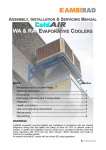
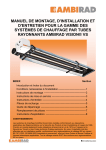
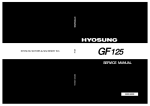
![Documentation technique VS-VSA [4192 ko]](http://vs1.manualzilla.com/store/data/006316293_1-cded0d07eb1da26f2a87274f7f721e39-150x150.png)
